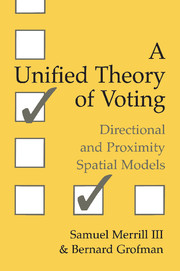1 - Introduction
Published online by Cambridge University Press: 04 December 2009
Summary
… how should a rational voter calculate the expected utility incomes from which he derives his expected party differential?
Anthony Downs, An Economic Theory of Democracy (1957: 39)How Do Voters Decide?
Imagine that you, a voter, must choose between two or more candidates for elective office. How will you decide for whom to vote? Political scientists and others have studied this question from both theoretical and descriptive perspectives. Roughly speaking they have offered what we might think of as three basic types of answers:
Answer one is that you will tend to vote for the candidate whose political party you have come to identify with. In classic works such as The American Voter (Campbell, Converse, Miller, and Stokes, 1960), scholars at the University of Michigan and elsewhere have developed this idea into what is often called the Michigan model of party identification. While not everyone will simply vote their party ID, party ID is seen as the best single advance predictor of the vote, with changing circumstances (such as economic conditions) giving rise to short-run and longer-run electoral forces that favor one candidate/party or another and that lead voters to deviate from their historical party identifications.
Answer two is that you will tend to vote for the candidate whose policy views are closest to your own. Following Anthony Downs (l957), we may think of both voters and candidates as points in some n-dimensional issue or policy space.
- Type
- Chapter
- Information
- A Unified Theory of VotingDirectional and Proximity Spatial Models, pp. 1 - 16Publisher: Cambridge University PressPrint publication year: 1999
- 1
- Cited by



